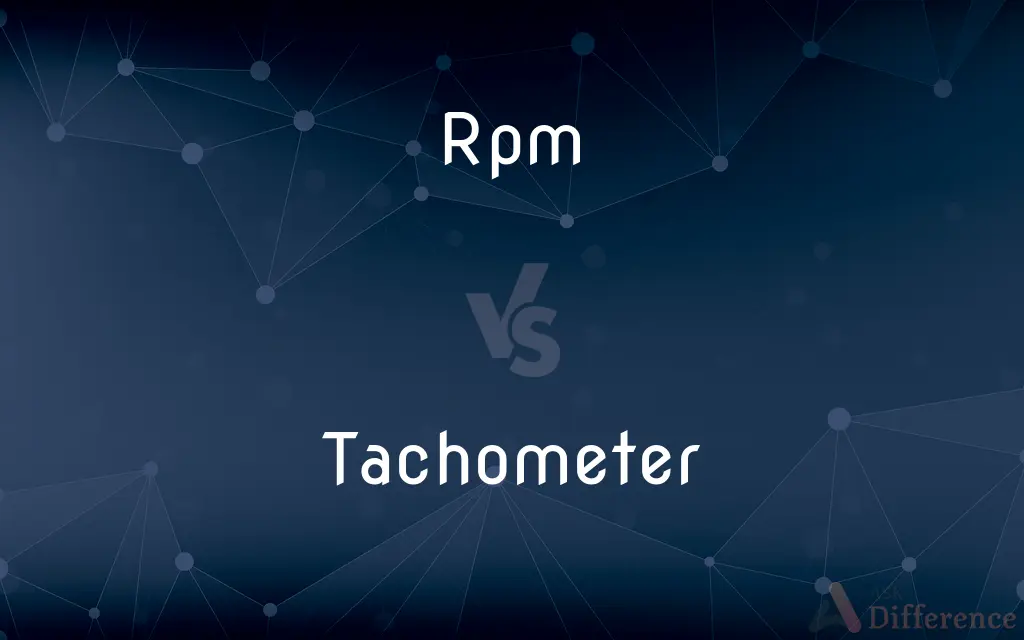Rpm vs. Tachometer — What's the Difference?
Edited by Tayyaba Rehman — By Fiza Rafique — Updated on March 26, 2024
RPM measures the speed of rotation, while a tachometer is a device that displays RPM.

Difference Between Rpm and Tachometer
Table of Contents
ADVERTISEMENT
Key Differences
RPM, which stands for revolutions per minute, quantifies how many times a rotating object completes a full rotation within one minute. It's a unit of measurement used to express the rotational speed of an object, such as a wheel, an engine's crankshaft, or a fan. A tachometer, on the other hand, is an instrument designed to measure and display the RPM of a rotating object. It is a tool that provides real-time data on the speed of rotation, which is crucial in various applications, from automotive to industrial.
While RPM is a numerical value, a tachometer can be analog or digital, visually representing the RPM through a dial and needle or a digital display. This distinction highlights RPM as a measure of performance or function, whereas tachometers are the means through which this performance is monitored and assessed. The relationship between them is direct; the tachometer reads the rotational speed and displays it in terms of RPM.
RPM is vital in understanding the operational state of machinery, vehicles, or any system involving rotational movement. High RPM values may indicate a system running at high efficiency or, conversely, a potential overworking and risk of damage. Tachometers, by providing these RPM readings, enable operators to make informed decisions about speed adjustments, ensuring optimal performance and safety of the equipment or vehicle.
In automotive applications, RPM is crucial for gauging the engine's workload and optimizing fuel efficiency, while tachometers are standard in vehicle dashboards, enabling drivers to visually monitor engine speed and make necessary adjustments. Similarly, in industrial settings, tachometers are used to ensure machinery operates within safe RPM limits, preventing wear and tear or mechanical failure.
The interpretation of RPM and the use of tachometers vary across different fields and applications. While all tachometers serve the same basic function of measuring rotational speed, their designs and the specific technologies they use can vary significantly, tailored to the requirements of the application, whether it be in automotive diagnostics, manufacturing processes, or hobbyist projects.
ADVERTISEMENT
Comparison Chart
Definition
A unit of measurement for rotational speed, indicating how many times an object rotates per minute.
An instrument for measuring and displaying RPM.
Nature
Numerical value.
Measuring device.
Application
Universal metric for rotational speed.
Used in vehicles, machinery, and various equipment to monitor RPM.
Representation
Expressed in numbers.
Can be analog or digital display.
Importance
Indicates efficiency, performance, or risk of damage.
Allows real-time monitoring and operational adjustments.
Compare with Definitions
Rpm
Indicator of machine efficiency.
Optimal performance was achieved at 1500 RPM.
Tachometer
Device measuring rotational speed.
The pilot checked the aircraft's tachometer for engine RPM.
Rpm
Critical for engine performance.
The mechanic adjusted the engine to maintain a steady 2000 RPM.
Tachometer
Used in machinery for safety.
The tachometer alerted us when the machine exceeded safe RPM limits.
Rpm
Reflects operational intensity.
The drill reached a maximum of 5000 RPM.
Tachometer
Can be digital or analog.
The new digital tachometer provided more accurate readings.
Rpm
Measurement of rotational speed.
The car's engine was running at 3000 RPM.
Tachometer
Essential for performance tuning.
Tuners use a tachometer to adjust engines for optimal RPM.
Rpm
Helps in assessing mechanical health.
Unusual RPM readings can indicate potential mechanical issues.
Tachometer
Integral part of vehicle dashboards.
The car's tachometer helps the driver avoid over-revving.
Rpm
Alternative case form of RPM
Tachometer
A tachometer (revolution-counter, tach, rev-counter, RPM gauge) is an instrument measuring the rotation speed of a shaft or disk, as in a motor or other machine. The device usually displays the revolutions per minute (RPM) on a calibrated analogue dial, but digital displays are increasingly common.
Rpm
Alternative case form of RPM
Tachometer
An instrument which measures the working speed of an engine (especially in a road vehicle), typically in revolutions per minute.
Rpm
Rate of revolution of a motor;
The engine was doing 6000 revs
Tachometer
An instrument used to measure the rotations per minute of a rotating shaft.
Tachometer
A device for measuring the revolutions per minute (RPMs) of a revolving shaft, as with the driveshaft of an automobile.
Tachometer
An instrument for measuring the velocity, or indicating changes in the velocity, of a moving body or substance.
Tachometer
An instrument for measuring the velocity of running water in a river or canal, consisting of a wheel with inclined vanes, which is turned by the current. The rotations of the wheel are recorded by clockwork.
Tachometer
An instrument for showing at any moment the speed of a revolving shaft, consisting of a delicate revolving conical pendulum which is driven by the shaft, and the action of which by change of speed moves a pointer which indicates the speed on a graduated dial.
Tachometer
Measuring instrument for indicating speed of rotation
Common Curiosities
Can RPM affect a vehicle's fuel efficiency?
Yes, operating a vehicle within optimal RPM ranges can enhance fuel efficiency.
Is a tachometer necessary in all vehicles?
While not absolutely necessary in all vehicles, it is crucial for manual transmission vehicles and performance monitoring.
What does RPM stand for?
RPM stands for revolutions per minute, a unit of rotational speed.
What is a tachometer used for?
A tachometer is used to measure and display the rotational speed of an object in RPM.
How can RPM readings indicate mechanical issues?
Unusual RPM fluctuations or levels can signal problems like misfires, air leaks, or other engine inefficiencies.
Can high RPM damage an engine?
Consistently operating an engine at excessively high RPM can lead to wear and potential damage.
How does a digital tachometer differ from an analog one?
A digital tachometer displays RPM readings numerically, whereas an analog one uses a dial and a moving needle.
How do RPM measurements help in industrial settings?
In industrial settings, RPM measurements ensure machinery operates within safe and efficient speed ranges.
Do all tachometers measure RPM in the same way?
Tachometers may use different technologies (e.g., optical, mechanical) to measure RPM, but the fundamental purpose is the same.
Is there a standard optimal RPM for all engines?
No, optimal RPM varies depending on the engine design, intended use, and operating conditions.
Why do race cars have large tachometers?
Large tachometers in race cars allow drivers to quickly monitor engine speed and make precise gear changes.
Are tachometers used only in automotive applications?
No, tachometers are also used in industrial machinery, aircraft, and boats to monitor rotational speed.
Can a tachometer measure the RPM of any rotating object?
Tachometers are designed for specific applications but can measure the RPM of any object if appropriately calibrated.
What happens if a tachometer fails?
If a tachometer fails, the operator may not be able to monitor RPM accurately, potentially leading to inefficient operation or damage.
Can changing RPM improve performance?
Yes, adjusting RPM to optimal levels can improve machinery or vehicle performance and efficiency.
Share Your Discovery

Previous Comparison
Extension vs. Intension
Next Comparison
Facsimile vs. ReplicaAuthor Spotlight
Written by
Fiza RafiqueFiza Rafique is a skilled content writer at AskDifference.com, where she meticulously refines and enhances written pieces. Drawing from her vast editorial expertise, Fiza ensures clarity, accuracy, and precision in every article. Passionate about language, she continually seeks to elevate the quality of content for readers worldwide.
Edited by
Tayyaba RehmanTayyaba Rehman is a distinguished writer, currently serving as a primary contributor to askdifference.com. As a researcher in semantics and etymology, Tayyaba's passion for the complexity of languages and their distinctions has found a perfect home on the platform. Tayyaba delves into the intricacies of language, distinguishing between commonly confused words and phrases, thereby providing clarity for readers worldwide.














































